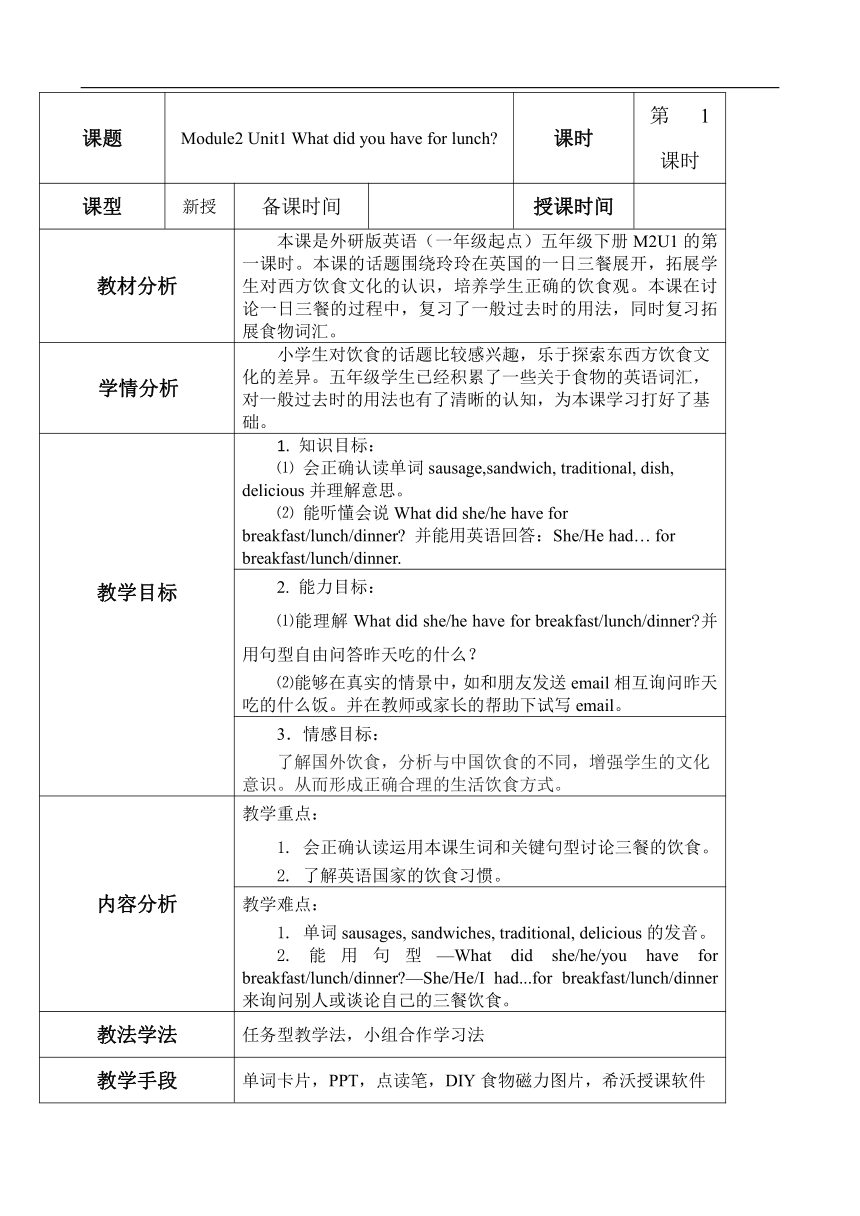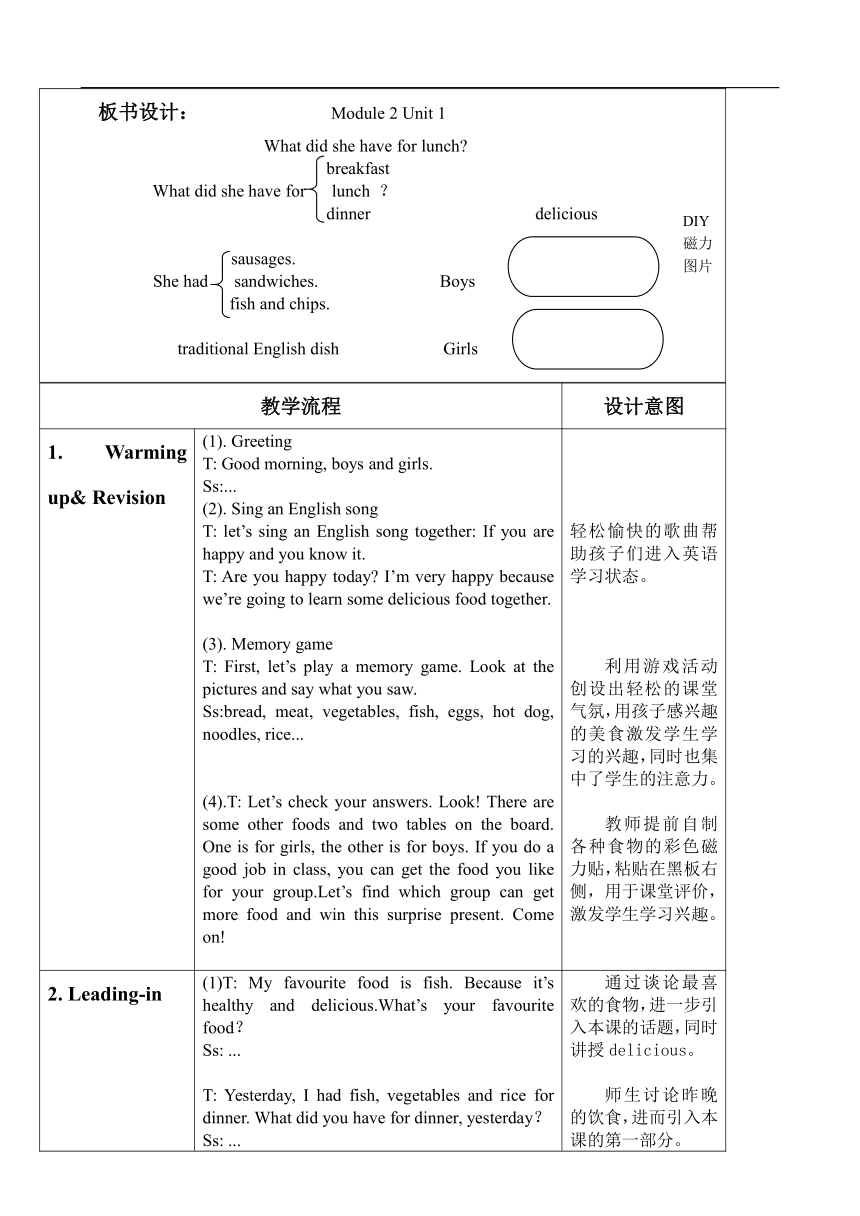Module2 Unit1 What did you have for lunch? 第一课时表格式教案
文档属性
| 名称 | Module2 Unit1 What did you have for lunch? 第一课时表格式教案 |  | |
| 格式 | doc | ||
| 文件大小 | 90.6KB | ||
| 资源类型 | 教案 | ||
| 版本资源 | 外研版(一年级起点) | ||
| 科目 | 英语 | ||
| 更新时间 | 2022-03-29 10:02:02 | ||
图片预览


文档简介
课题 Module2 Unit1 What did you have for lunch 课时 第 1 课时
课型 新授 备课时间 授课时间
教材分析 本课是外研版英语(一年级起点)五年级下册M2U1的第一课时。本课的话题围绕玲玲在英国的一日三餐展开,拓展学生对西方饮食文化的认识,培养学生正确的饮食观。本课在讨论一日三餐的过程中,复习了一般过去时的用法,同时复习拓展食物词汇。
学情分析 小学生对饮食的话题比较感兴趣,乐于探索东西方饮食文化的差异。五年级学生已经积累了一些关于食物的英语词汇,对一般过去时的用法也有了清晰的认知,为本课学习打好了基础。
教学目标 知识目标:⑴ 会正确认读单词sausage,sandwich, traditional, dish, delicious并理解意思。⑵ 能听懂会说What did she/he have for breakfast/lunch/dinner 并能用英语回答:She/He had… for breakfast/lunch/dinner.
能力目标: ⑴能理解What did she/he have for breakfast/lunch/dinner 并用句型自由问答昨天吃的什么?⑵能够在真实的情景中,如和朋友发送email相互询问昨天吃的什么饭。并在教师或家长的帮助下试写email。
3.情感目标:了解国外饮食,分析与中国饮食的不同,增强学生的文化意识。从而形成正确合理的生活饮食方式。
内容分析 教学重点:1. 会正确认读运用本课生词和关键句型讨论三餐的饮食。2. 了解英语国家的饮食习惯。
教学难点:1. 单词sausages, sandwiches, traditional, delicious的发音。2.能用句型—What did she/he/you have for breakfast/lunch/dinner —She/He/I had...for breakfast/lunch/dinner来询问别人或谈论自己的三餐饮食。
教法学法 任务型教学法,小组合作学习法
教学手段 单词卡片,PPT,点读笔,DIY食物磁力图片,希沃授课软件
板书设计: Module 2 Unit 1 What did she have for lunch breakfast What did she have for lunch ? dinner delicious sausages. She had sandwiches. Boys fish and chips. traditional English dish Girls
教学流程 设计意图
1. Warming up& Revision (1). GreetingT: Good morning, boys and girls.Ss:...(2). Sing an English songT: let’s sing an English song together: If you are happy and you know it.T: Are you happy today I’m very happy because we’re going to learn some delicious food together.(3). Memory gameT: First, let’s play a memory game. Look at the pictures and say what you saw.Ss:bread, meat, vegetables, fish, eggs, hot dog, noodles, rice...(4).T: Let’s check your answers. Look! There are some other foods and two tables on the board. One is for girls, the other is for boys. If you do a good job in class, you can get the food you like for your group.Let’s find which group can get more food and win this surprise e on! 轻松愉快的歌曲帮助孩子们进入英语学习状态。利用游戏活动创设出轻松的课堂气氛,用孩子感兴趣的美食激发学生学习的兴趣,同时也集中了学生的注意力。教师提前自制各种食物的彩色磁力贴,粘贴在黑板右侧,用于课堂评价,激发学生学习兴趣。
2. Leading-in (1)T: My favourite food is fish. Because it’s healthy and delicious.What’s your favourite food?Ss: ...T: Yesterday, I had fish, vegetables and rice for dinner. What did you have for dinner, yesterday?Ss: ...(2)T: What about Daming and Tom What did they have for dinner Let’s have a look!Ss: ...T: What did Daming have for dinner What did Tom have for dinner Ss: ...T: Let’s listen and chant together. 通过谈论最喜欢的食物,进一步引入本课的话题,同时讲授delicious。师生讨论昨晚的饮食,进而引入本课的第一部分。学生带着问题观看活动1动画。初步感知如何谈论吃过的饮食。
3.Presentation T: Today, we are going to talk about what we had yesterday and know more about English food. I hope, after class, you can ask and answer about what you had yesterday, and try to write an Email about it. 教师提出本课的学习任务,帮助学生明确学习目标。
4.New lesson (1). T: Look! Daming had got an Email from Lingling. Let’s watch the cartoon together and finWhat's the email about Ss:…T: Let’s look at the email together. Subject means 主题 in Chinese. The subject of this email is English food.(2). T: Yesterday Lingling had some English food. What did she have for breakfast, lunch and dinner?Let’s listen, read and find the answers.Ss: ...(教师将关键句型 What did she have for breakfast/ lunch/ dinner She had...粘贴在黑板上。教师讲解词汇sausages, sandwiches, fish and chips。教师播放介绍fish and chips的视频,让学生在真是的情景中感知西方的饮食文化。)(3). T: Let’s watch and read the dialogue, try to follow.T: Let’s know more about fish and chips. It’s a traditional English dish.(教师讲解词汇traditional, dish)T: Do you know some Chinese traditional food.?Let’s have a look.(4).T: Read the dialogue with your friend. 教师借助活动2第一部分图片直接引出活动2的内容。学生带着问题看动画,对对话情节整体感知。同时引导学生关注英文邮件的发件人,主题相关内容。学生带着问题,听音,模仿对话。再次跟读对话,强调模仿,纠正发音。强化 sausage(s), sandwich(es) 的正确发音。教师引导学生对比东西方传统食物。同桌间分角色朗读对话,进行汇报。
5.Practise (1).T: Please take out this sheet of paper. Look at Task 1. First tick, then talk with your friends what you had yesterday. (课前,教师分发了任务单。在这个环节,教师指导学生选择并讨论自己昨天的饮食。)(2).T: Look at Task 2. Fill in the blanks to finish the email. Later, you can read your email to us.(任务二是给玲玲回一封电子邮件,描述自己昨天的饮食。教师指导学生填空,完成邮件。请个别同学到前面朗读邮件,教师点评,并概括邮件写作要求。这一部分,教师会利用希沃授课软件同步投屏学生的写作内容。) 生生问答,应用课堂所学。教师指导学生完成电子邮件,进一步应用本课所学。从而完成英语学习从听、读到说、写的过渡。
Extension T: Do you want to know more about English food culture Let’s watch a video.T: How many meals do English people have one day Ss: They have four meals one day.T: How many meals do we have one day Ss: We have three meals one day.T: English food culture is different from Chinese food culture. Let’s find more differences next class. 教师播放介绍英国四餐饮食文化的视频,让学生进一步感知英国的饮食文化,对比中西方饮食文化的差异,为下节的学习埋下伏笔。
7. Summary (1). T: What did you learn today Ss:...T: Yes, today we talked about food, especially English food. And We also learned to ask and answer what we had. I have a sentence to share with you, “ You are what you eat!”. Eat healthy dishes, then you will be healthy.(2) T: Which group is the winner Congratulation! Guess what’s the present. I hope you can share it. 师生共同回顾本课所学,巩固知识,提高学生对知识的归纳能力。同时,教师寄语,有意培养学生健康的饮食习惯。教师对学生的课堂表现进行评价,激励他们不断努力。
8.Homework (1). Listen and read part1& part 2.(2). Finish the exercises on the exercise book.(3). Talk about with your friends what English food you had before . 课后作业帮助学生从听、说、读、写各方面巩固,应用课堂所学。
任务单
任务一:
Tick and talk. (先打√选择自己吃的食物,然后同桌问答。)
A:Yesterday, what did you have for breakfast/ lunch/ dinner
B: I had ...
Food noodles eggs sausages meat fish sandwiches vegetables rice
breakfast
lunch
dinner
任务二:
你刚刚收到Lingling从英国发来的邮件,现在给Lingling回一封邮件吧!Lingling 的邮箱地址:Lingling@ ( mailto:Lingling@ )
DIY
磁力
图片
Dear ,
How are you I'm happy to have an email from you. English food is so . I want to have some English food, too. Do you want to know what I had yesterday I had for breakfast. I had for . I
for dinner. I like both Chinese and
English food. Have a great time in England!
Yours,
课型 新授 备课时间 授课时间
教材分析 本课是外研版英语(一年级起点)五年级下册M2U1的第一课时。本课的话题围绕玲玲在英国的一日三餐展开,拓展学生对西方饮食文化的认识,培养学生正确的饮食观。本课在讨论一日三餐的过程中,复习了一般过去时的用法,同时复习拓展食物词汇。
学情分析 小学生对饮食的话题比较感兴趣,乐于探索东西方饮食文化的差异。五年级学生已经积累了一些关于食物的英语词汇,对一般过去时的用法也有了清晰的认知,为本课学习打好了基础。
教学目标 知识目标:⑴ 会正确认读单词sausage,sandwich, traditional, dish, delicious并理解意思。⑵ 能听懂会说What did she/he have for breakfast/lunch/dinner 并能用英语回答:She/He had… for breakfast/lunch/dinner.
能力目标: ⑴能理解What did she/he have for breakfast/lunch/dinner 并用句型自由问答昨天吃的什么?⑵能够在真实的情景中,如和朋友发送email相互询问昨天吃的什么饭。并在教师或家长的帮助下试写email。
3.情感目标:了解国外饮食,分析与中国饮食的不同,增强学生的文化意识。从而形成正确合理的生活饮食方式。
内容分析 教学重点:1. 会正确认读运用本课生词和关键句型讨论三餐的饮食。2. 了解英语国家的饮食习惯。
教学难点:1. 单词sausages, sandwiches, traditional, delicious的发音。2.能用句型—What did she/he/you have for breakfast/lunch/dinner —She/He/I had...for breakfast/lunch/dinner来询问别人或谈论自己的三餐饮食。
教法学法 任务型教学法,小组合作学习法
教学手段 单词卡片,PPT,点读笔,DIY食物磁力图片,希沃授课软件
板书设计: Module 2 Unit 1 What did she have for lunch breakfast What did she have for lunch ? dinner delicious sausages. She had sandwiches. Boys fish and chips. traditional English dish Girls
教学流程 设计意图
1. Warming up& Revision (1). GreetingT: Good morning, boys and girls.Ss:...(2). Sing an English songT: let’s sing an English song together: If you are happy and you know it.T: Are you happy today I’m very happy because we’re going to learn some delicious food together.(3). Memory gameT: First, let’s play a memory game. Look at the pictures and say what you saw.Ss:bread, meat, vegetables, fish, eggs, hot dog, noodles, rice...(4).T: Let’s check your answers. Look! There are some other foods and two tables on the board. One is for girls, the other is for boys. If you do a good job in class, you can get the food you like for your group.Let’s find which group can get more food and win this surprise e on! 轻松愉快的歌曲帮助孩子们进入英语学习状态。利用游戏活动创设出轻松的课堂气氛,用孩子感兴趣的美食激发学生学习的兴趣,同时也集中了学生的注意力。教师提前自制各种食物的彩色磁力贴,粘贴在黑板右侧,用于课堂评价,激发学生学习兴趣。
2. Leading-in (1)T: My favourite food is fish. Because it’s healthy and delicious.What’s your favourite food?Ss: ...T: Yesterday, I had fish, vegetables and rice for dinner. What did you have for dinner, yesterday?Ss: ...(2)T: What about Daming and Tom What did they have for dinner Let’s have a look!Ss: ...T: What did Daming have for dinner What did Tom have for dinner Ss: ...T: Let’s listen and chant together. 通过谈论最喜欢的食物,进一步引入本课的话题,同时讲授delicious。师生讨论昨晚的饮食,进而引入本课的第一部分。学生带着问题观看活动1动画。初步感知如何谈论吃过的饮食。
3.Presentation T: Today, we are going to talk about what we had yesterday and know more about English food. I hope, after class, you can ask and answer about what you had yesterday, and try to write an Email about it. 教师提出本课的学习任务,帮助学生明确学习目标。
4.New lesson (1). T: Look! Daming had got an Email from Lingling. Let’s watch the cartoon together and finWhat's the email about Ss:…T: Let’s look at the email together. Subject means 主题 in Chinese. The subject of this email is English food.(2). T: Yesterday Lingling had some English food. What did she have for breakfast, lunch and dinner?Let’s listen, read and find the answers.Ss: ...(教师将关键句型 What did she have for breakfast/ lunch/ dinner She had...粘贴在黑板上。教师讲解词汇sausages, sandwiches, fish and chips。教师播放介绍fish and chips的视频,让学生在真是的情景中感知西方的饮食文化。)(3). T: Let’s watch and read the dialogue, try to follow.T: Let’s know more about fish and chips. It’s a traditional English dish.(教师讲解词汇traditional, dish)T: Do you know some Chinese traditional food.?Let’s have a look.(4).T: Read the dialogue with your friend. 教师借助活动2第一部分图片直接引出活动2的内容。学生带着问题看动画,对对话情节整体感知。同时引导学生关注英文邮件的发件人,主题相关内容。学生带着问题,听音,模仿对话。再次跟读对话,强调模仿,纠正发音。强化 sausage(s), sandwich(es) 的正确发音。教师引导学生对比东西方传统食物。同桌间分角色朗读对话,进行汇报。
5.Practise (1).T: Please take out this sheet of paper. Look at Task 1. First tick, then talk with your friends what you had yesterday. (课前,教师分发了任务单。在这个环节,教师指导学生选择并讨论自己昨天的饮食。)(2).T: Look at Task 2. Fill in the blanks to finish the email. Later, you can read your email to us.(任务二是给玲玲回一封电子邮件,描述自己昨天的饮食。教师指导学生填空,完成邮件。请个别同学到前面朗读邮件,教师点评,并概括邮件写作要求。这一部分,教师会利用希沃授课软件同步投屏学生的写作内容。) 生生问答,应用课堂所学。教师指导学生完成电子邮件,进一步应用本课所学。从而完成英语学习从听、读到说、写的过渡。
Extension T: Do you want to know more about English food culture Let’s watch a video.T: How many meals do English people have one day Ss: They have four meals one day.T: How many meals do we have one day Ss: We have three meals one day.T: English food culture is different from Chinese food culture. Let’s find more differences next class. 教师播放介绍英国四餐饮食文化的视频,让学生进一步感知英国的饮食文化,对比中西方饮食文化的差异,为下节的学习埋下伏笔。
7. Summary (1). T: What did you learn today Ss:...T: Yes, today we talked about food, especially English food. And We also learned to ask and answer what we had. I have a sentence to share with you, “ You are what you eat!”. Eat healthy dishes, then you will be healthy.(2) T: Which group is the winner Congratulation! Guess what’s the present. I hope you can share it. 师生共同回顾本课所学,巩固知识,提高学生对知识的归纳能力。同时,教师寄语,有意培养学生健康的饮食习惯。教师对学生的课堂表现进行评价,激励他们不断努力。
8.Homework (1). Listen and read part1& part 2.(2). Finish the exercises on the exercise book.(3). Talk about with your friends what English food you had before . 课后作业帮助学生从听、说、读、写各方面巩固,应用课堂所学。
任务单
任务一:
Tick and talk. (先打√选择自己吃的食物,然后同桌问答。)
A:Yesterday, what did you have for breakfast/ lunch/ dinner
B: I had ...
Food noodles eggs sausages meat fish sandwiches vegetables rice
breakfast
lunch
dinner
任务二:
你刚刚收到Lingling从英国发来的邮件,现在给Lingling回一封邮件吧!Lingling 的邮箱地址:Lingling@ ( mailto:Lingling@ )
DIY
磁力
图片
Dear ,
How are you I'm happy to have an email from you. English food is so . I want to have some English food, too. Do you want to know what I had yesterday I had for breakfast. I had for . I
for dinner. I like both Chinese and
English food. Have a great time in England!
Yours,
同课章节目录
- Module 1
- Unit 1 She was a driver before.
- Unit 2 He worked in an office .
- Module 2
- Unit 1 What did she have for lunch?
- Unit 2 Lunch is usually at half past twelve.
- Module 3
- Unit 1 Have you got the Harry Potter DVDs?
- Unit 2 You can use the computers.
- Module 4
- Unit 1 Did you read them?
- Unit 2 My favourite season is spring.
- Module 5
- Unit 1 Your bag is broken.
- Unit 2 Mine is pink.
- Module 6
- Unit 1 We' ll see lots of very big stones.
- Unit 2 It was amazing.
- Module 7
- Unit 1 My father goes to work at 8 o'clock every m
- Unit 2 I'll be home at 7 o’clock.
- Module 8
- Unit 1 Will you help me ?
- Unit 2 I made a kite.
- Module 9
- Unit 1 We laughed a lot.
- Unit 2 Mum bought new chopsticks for you.
- Module 10
- Unit 1 What did you put in your bag ?
- Unit 2 I played on the beach.
- Review Module
- Unit 1
- Unit 2
